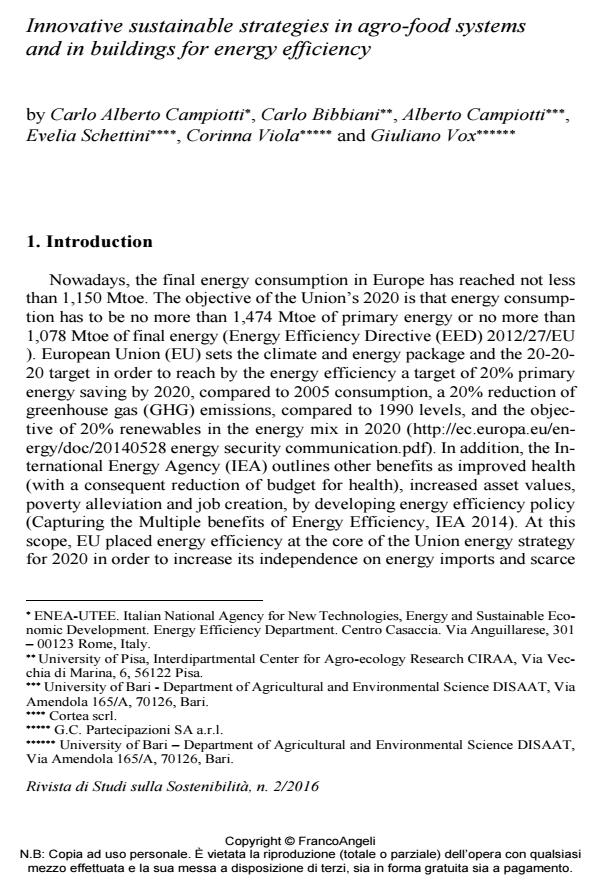Innovative sustainable strategies in agro-food systems and in buildings for energy efficiency
Titolo Rivista RIVISTA DI STUDI SULLA SOSTENIBILITA'
Autori/Curatori Carlo Alberto Campiotti, Carlo Bibbiani, Alberto Campiotti, Evelia Schettini, Corinna Viola, Giuliano Vox
Anno di pubblicazione 2017 Fascicolo 2016/2
Lingua Inglese Numero pagine 18 P. 79-96 Dimensione file 636 KB
DOI 10.3280/RISS2016-002008
Il DOI è il codice a barre della proprietà intellettuale: per saperne di più
clicca qui
Qui sotto puoi vedere in anteprima la prima pagina di questo articolo.
Se questo articolo ti interessa, lo puoi acquistare (e scaricare in formato pdf) seguendo le facili indicazioni per acquistare il download credit. Acquista Download Credits per scaricare questo Articolo in formato PDF

FrancoAngeli è membro della Publishers International Linking Association, Inc (PILA)associazione indipendente e non profit per facilitare (attraverso i servizi tecnologici implementati da CrossRef.org) l’accesso degli studiosi ai contenuti digitali nelle pubblicazioni professionali e scientifiche
EU identified the energy efficiency policy as the major strategy for ensuring both the sustainability of the use of energy resources and to develop the transition towards a low-carbon and decentralized energy system in Europe. This paper presents a brief analysis on available innovative technologies to reduce the dependency of agriculture and agro-food sector from fossil energy, and comply with the international commitment to reduce greenhouse emissions and to combat climate change. A general overview is provided on the energy consumption in agriculture and agro-food sector, with particular focus on the Italian sector is taken into consideration. It is discussed the role of solid biomass in place of fossil resources and the application of solar cooling technology as new technologies for acclimatization in greenhouse agriculture. Moreover, the application of living vegetated horizontal and vertical layers on buildings is evaluated as innovative and natural technology for improving the sustainability of towns and reducing the energy consumption for air conditioning in summer and CO2 emissions in towns.
L’efficienza energetica rappresenta la policy europea di maggiore interesse per favorire la riduzione dei consumi energetici nei diversi settori produttivi e la riduzione delle emissioni di CO2. In particolare, questo lavoro è focalizzato sul settore agricoltura e industria alimentare nazionale di cui riporta un quadro generale in termini di consumi energetici delle diverse filiere produttive; inoltre il lavoro brevemente affronta le innovazioni disponibili per migliorare l’efficienza energetica ai fini della diminuzione dei consumi di energia fossile nella produzione di beni alimentari. Vengono descritte le caratteristiche tecniche relative all’impiego della biomassa solida e alla tecnologia solar cooling per la climatizzazione nel comparto dei sistemi serra. Inoltre, viene presa in considerazione la tecnologia dei tetti verdi e delle pareti vegetali per sostenere il miglioramento dell’efficienza energetica degli edifici e la diminuzione delle emissioni di CO2 nelle città. .
Parole chiave:Agroindustria, efficienza energetica, agricoltura, consumi energetici, tetti verdi e pareti vegetali
- Climate control inside a greenhouse by means of a solar cooling system G. Puglisi, G. Vox, E. Schettini, G. Morosinotto, C.A. Campiotti, in Acta Horticulturae /2018 pp.61
DOI: 10.17660/ActaHortic.2018.1227.7 - Shading screens and ventilation efficiency in a naturally ventilated greenhouse by means of CFD modeling E. Santolini, A. Barbaresi, B. Pulvirenti, D. Torreggiani, P. Tassinari, in Acta Horticulturae /2021 pp.327
DOI: 10.17660/ActaHortic.2021.1311.41 - Experimental results of a solar cooling system for greenhouse climate control G. Puglisi, G. Vox, C.A. Campiotti, G. Scarascia Mugnozza, E. Schettini, in Acta Horticulturae /2020 pp.1107
DOI: 10.17660/ActaHortic.2020.1296.140 - Geo-Economy of the Future Irina B. Mironova, Lilia R. Moiseeva, Elmira F. Nigmatulina, Marina G. Mirgorodskaya, pp.885 (ISBN:978-3-030-92302-0)
Carlo Alberto Campiotti, Carlo Bibbiani, Alberto Campiotti, Evelia Schettini, Corinna Viola, Giuliano Vox, Innovative sustainable strategies in agro-food systems and in buildings for energy efficiency in "RIVISTA DI STUDI SULLA SOSTENIBILITA'" 2/2016, pp 79-96, DOI: 10.3280/RISS2016-002008